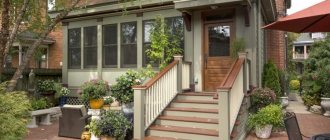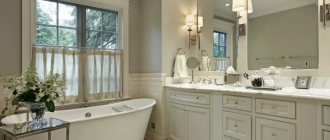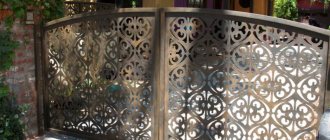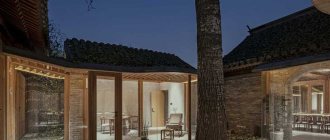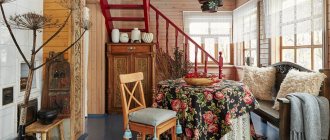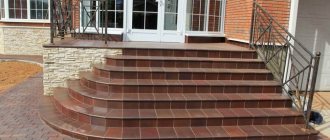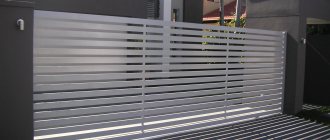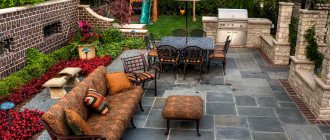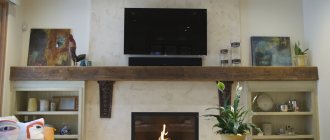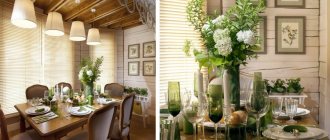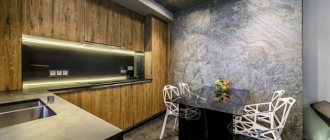Illumination of the facade of a wooden house
The desire for environmental friendliness and escape from the stone streets of cities is an undeniable trend of recent times, which has resulted in a boom in the construction of country houses and cottages made of wood, often laminated timber. According to statistics, the majority of owners of such houses are quite young, modern people who keep up with the times, use new technologies, embody modern design and materials. And of course, where would we be without light? And here we will describe only the features of solutions for external lighting of the facades of houses made of timber.
Requirements for street lamps
Installation of street light sources involves year-round exposure of lamps and lanterns to a number of meteorological influences.
Taking this factor into account, all purchased lamps must meet a number of requirements:
- Sufficient strength of the products, especially the lampshade.
- Moisture resistant.
- Availability of grounding.
- Ease of practical maintenance of the lamp, especially spring and autumn cleaning.
The photo of the façade lighting shows that all lamps are equipped with durable and moisture-resistant shades.
The shape and design of a garden lamp must fully correspond to the interior of a summer cottage or private house.
Types of exterior lighting additions
As for the lighting additions to the external lighting of a private home, they are divided into the following groups:
- Accent lighting of the facade is a fragmentary highlighting technique that allows you to draw attention to some architectural elements that emphasize the attractiveness of the building. These include the following details: niches and columns, statues and stucco, family coats of arms. Lighting can be monochromatic or colored, it all depends on the style of the building and its dimensions.
- Contour lighting is based on cords and tubes with LEDs, which serve as an excellent decoration for the facade of a large private house. This technology makes it possible to emphasize the façade of a home as a whole, only to highlight its individual functional components, for example, a balcony or roof, a staircase or bay window, balustrades or columns.
- Hidden lighting is decorative lighting used to illuminate protruding areas of the facade. This technology is often used to decorate cornices and the lower part of balcony slabs, thanks to which it is possible to achieve more expressive outlines of the outer part of the home. Also, with the help of hidden lighting, you can focus attention on the design features of the structure and the texture of the external cladding. This type of lighting creates a soft glow created by LED or neon strips.
- Dynamic architectural lighting is based on the play of light and shadow, the combination of radiation brightness, its depth and a wide color palette.
- Flood light is a basic solution designed to present the overall exterior of a private home. Most often used for buildings built of brick or stone, with lamps placed on the ground or in roof elements.
Types of facade lamps
All commercially available light sources differ in a number of parameters, including size, shape, lamp power, and color temperature.
There are a number of differences in the method of installing decorative lighting:
- The luminaires can be mounted directly into the facades of residential and auxiliary buildings. When choosing such models, you should pay maximum attention to the methods of securing the fastenings.
- Ground lights. Such sources for facade lighting are of particular value. Various models may have support posts, for example, twisted metal or reinforced iron. Small lamps on short stands are placed along garden paths to visually highlight the pedestrian area.
- Hanging models. These include sconces, ceiling chandeliers and lampshades that can illuminate a sufficient area. They are most often used for arrangement on a summer terrace, under a canopy, at the entrance to a house or garage, in a summer kitchen.
- One of the latest trends of the season in landscape design is recessed lighting. These include spotlights that very beautifully emphasize the style of a garden plot and highlight a particular area of the house.
In addition, ground lamps are often used, which are installed directly on the site with green spaces. Such models are equipped with a durable body and are resistant to moisture and temperature changes. It is up to the owner of the garden plot to decide which lamps are best to choose for illuminating facades.
Types of wooden houses
Conventionally, timber houses can be divided into standard, “with outbuildings,” single-story, multi-story, and composite houses. We will consider a standard house to be a house built into the understanding of a rectangle when viewed from above, without taking into account the adjacent gazebos and verandas.
Standard timber house
A wooden house “with outbuildings” is one of the most common and often found in various modifications.
House with outbuildings
One-story house made of timber
Less common are complex houses with more than 2 floors:
Complex house
3-storey house
Optimal selection parameters
Purchasing a specific model of luminaires for installing façade lighting requires a detailed approach.
The future owner should pay attention to the following factors:
- Level of protection against moisture and dust. On the product packaging you can find the IP index, which indicates the degree of protection of the product from various external influences.
- The strength of the housing or lampshade, which allows you to place the light source in an open space. The most popular lampshades are made of tempered glass, universal plastic, and lightweight and corrosion-resistant aluminum.
- Type of lamps used. For street lighting, more and more preference is given to LED lamps or halogen lamps, which make it possible to illuminate the courtyard area very effectively, and at the same time, save financial costs on electricity.
- Rating of manufacturing companies. Immediately before purchasing a particular model of façade lamp, you should read the reviews about the manufacturing company.
- Before purchasing a lamp or luminaire, you should carefully inspect it for external damage, cracks, chips, and the presence of wiring insulation.
You should also check with the seller about the product’s maintenance requirements, expected service life, power and presence of a motion sensor.
If installation of the sensor is not provided for in production conditions, you can verify the possibility of self-installation.
Selection of architectural lamps
Everything described above is, of course, applied to professional lamps. Conventional decorative lamps do not have in their characteristics the function of directivity of light, achieved by the angle of the pre-installed lens.
Most often, single-beam luminaires are used for façade lighting, less often bidirectional (two-beam) luminaires. You can see the equipment we use on the architectural lighting page.
In this article we will not consider LED strip lighting, for a simple reason - capriciousness to the external environment, a relatively short period of stable operation, diffused light, without directionality, and also an order of magnitude higher energy consumption when compared with lamps. It is also impossible not to mention linear lamps, with the help of which it is possible to effectively illuminate horizontal lines.
Nowadays it is correct to use lamps with built-in LEDs. Their service life allows you to forget about maintenance for 12-15 years, which cannot be said about lamp lamps, where the service life is an order of magnitude lower. In addition, professional LED lamps, due to the correct optics, allow you to achieve the desired effect even with a minimum power of 3-5W.
What else is important to know about choosing lamps
- light temperature - usually for houses made of timber it is warm white 3000K,
- the width of the lens angle - this determines how long the beam will be and how wide its illumination sector will be,
- lamp power - taking into account the lens, the lamp visually gives an enhanced spot of light at the beginning of the beam, the correct choice will avoid the visual effect of “burning” the beginning of the illuminated area,
- availability of a choice of mounting brackets - it is better if it is a closed mounting bracket that allows you to hide the supplied cable,
- the ability to use non-standard brackets for external and internal corners,
- the possibility of a protective hood option for lamps installed in the lower part of the facade, which is a decorative physical obstacle for the human eye to meet the lamp’s LED,
- it is correct that the lamp body is made of an alloy that allows heat to be removed (diodes are indifferent to cold, but do not like overheating),
- It’s very good if there is an option to choose the color of the case.
Calculation of façade lighting
The first and most important step for the future owner is to calculate the required lighting for the building's facade. This indicator directly depends on the initial area of the garden plot, the size of the load-bearing wall for placing hanging lanterns and lamps, and the presence of a decorative gazebo or other recreation area for the owners.
In addition, the preliminary design must take into account the materials used for exterior finishing in order to install façade lamps. For ground lamps, it is advisable to know the level of soil acidity, which can have a detrimental effect on the base and lampshade material. The calculation is carried out in accordance with the requirements of GOST.
How to calculate façade lighting:
- External architectural lighting should provide good visibility and figurative expressiveness of the most important objects, and the comfort of the light environment, help identify the originality of the composition and the quality of planning and development.
- The lighting created should have a beneficial effect on the psychological mood of the residents of the house.
- To illuminate objects with “cold-white” color shades of surfaces and green spaces, lamps with a color temperature of 4000 to 6000 K should be used. To illuminate objects with “warm white” colors, lamps with a color temperature of 2200 to 3500 K should be used. .
Light sources with a power of more than 150 W, installed directly on the ground at the level of possible human contact with heated parts, must be equipped with decorative protective covers.
Illumination of country houses: a little history
Designer Elena Golubkova has already told FORUMHOUSE readers about the role light plays in the interior of any building. It is no less important in the exterior: a well-designed outdoor lighting system can transform even an ordinary wooden building into a masterpiece without rebuilding or expensive finishing. Architectural lighting allows you to protect your home from thieves, and you from having to look for the keyhole in the dark.
Of course, facade lighting is not an invention of today. Torches were attached to the walls of buildings back in Ancient Rome, caring not so much about the beauty of the buildings, but about illuminating the streets at night. Torch lighting was common in Europe until the invention of kerosene lanterns and electricity - torch holders are now available on the outside of many buildings in England, France, and Italy. “Florence comes to me, phosphorescent with its houses, and, like a butler, unlocks its palazzos and fogs,” the poet Andrei Voznesensky shares the image in the poem “Florentine Torches.”
We talked in detail about how architectural lighting has evolved from torches to LEDs in our article. Our experts tell us how modern home lighting works.
Installation of facade lighting
After selecting the light source, type of lamps and type of luminaire, you can proceed directly to installation work.
To do this, follow the instructions on how to illuminate the facade:
- First of all, it is necessary to select the type of facade lighting: local, widespread, artistic or dynamic lighting (using LED lamps).
- The next stage of independent work is to repair the facade. All installation work is carried out only after defects in buildings and external finishing materials have been eliminated.
- All wiring for decorative lamps should be connected to a separate circuit breaker in the panel.
In addition, the wiring should be enclosed in corrugated tubing or other type of insulating material.
Next, they mount the lamps, and only then begin to connect the electrical wiring. If you plan to install a timer or motion sensor, then do the installation at this stage.
How to Make an Architectural Lighting Plan
Lighting the outside of any home, be it a small hut or a three-story cottage, begins with a project. You can do it yourself - draw a plan on paper and outline the main zones that you would like to highlight. The second option is to order a more detailed 3D visualization from a design bureau that deals with outdoor lighting. It might look something like this:
Dmitry Petrenko, project manager for a wooden country house in the chalet style.
When developing an architectural lighting plan, it is important to take into account the location of the house relative to nearby buildings. Consider whether the exterior lighting of your home will glare into your neighbors’ windows. And, based on this, choose the type and location of lighting devices.
Photo of house facade lighting
Share with friends
Street lighting of a private house: pros and limitations
Despite the obvious positive aspects, home lighting has some limitations that you need to be aware of.
Advantages
When planning the lighting of a country house site, you should start directly from the building itself.
First of all, the illuminated facade looks great when viewed from the outside of the house. However, it is not always necessary to install a large number of lamps. Even garlands hung under the roof canopy add significant variety to the exterior of the house. But if desired, the walls of a home or the architectural features of a building can be used to create amazingly beautiful paintings.
Another point is that the house becomes special, with its own zest, and you can always refer to some characteristic features in the lighting solution that will help you quickly find the building among all the others.
Another plus is that the lamps can be installed in such a way that they illuminate not only the building, but also the area near it. It will be possible to move around the house without any problems.
Peculiarities
It is necessary to install lighting fixtures in such a way that their light does not fall into the windows of neighboring houses, does not blind passersby and is not excessively strong - if you have to block the spotlight from the spotlight with thick curtains, you should reconsider its location and lamp power.
Lamps should not be visually overloaded - a lighting fixture that is too large or too small will not only not give the expected effect, but will also look ridiculous. It is also worth using a computer program that will help calculate the required number of lamps, their location, appearance and lamp power.
Decorative lighting outside a country house should also take into account the degree of security of the installed lighting fixtures. It is indicated by the IP icon with two numbers: the first shows how protected the electrical part of the equipment is from dust, the second is the protection against moisture. Based on this, facade lighting requires a degree of protection of at least 44 - the design of such lamps does not allow objects larger than 1 mm to pass through, and is not afraid of either rain or a stream of water from a hose. The higher the numbers, the lower the possibility of the lamp becoming dusty and getting wet.
As for the materials from which lighting fixtures are made, metal, in particular aluminum, has proven itself to be the best. It is lightweight and non-corrosive. It is also better if the body is not prefabricated, but cast - it is more reliable.
Functions and purpose
Lighting the yard and surrounding area performs several functions at once:
- Security. In illuminated areas, there is less chance of getting away with impunity, which is why attackers try to avoid such areas. For security, they place lamps near the gate, on the porch, near outbuildings. They are placed at a considerable height to illuminate a larger area. The peculiarity of this type of street lighting is that it stays on all night. There is an option to save money - install motion sensors. With this device, the light turns on only when there is at least some movement in the sensor’s coverage area.
Street lighting of a private house
- Ensuring travel safety. To avoid stepping on something left on the path in the dark, they are also usually illuminated. Lighting is required on stairs and around water bodies. Most often, special street lights with medium-height legs are used for this. They are installed at some distance from each other on one or both sides of the track. This lighting is turned on until the owners go to bed.
It is very important to highlight stairs and paths
- Decorative. To make the yard or garden look no less attractive in the evening than during the day, use decorative lighting. It is usually located on an open veranda, gazebo, near a pond or fountain, or other decorative elements on the site. With such lighting, street wall lamps, garlands, LED strips, etc. are used. This street lighting at home works only when necessary. Decorative lighting gives the garden and yard a special charm
- Festive. To create a festive atmosphere, houses and yards are decorated. Festive illumination is not mandatory, but such a nice type of lighting.
Festive street lighting at home
Usually the lighting on the site of a house - country or country house - is comprehensive. There are at least a lantern at the doors and gates, and a couple of lanterns along the main paths. Floodlights controlled from the house can be installed to illuminate the area if necessary. This is the minimum that ensures a normal degree of safety and convenience.
Selection of lighting elements
In addition to the fact that lamps for outdoor lighting of houses must have the property of saving energy at high luminous intensity, they are also subject to “mechanical” requirements:
- The lamp must be placed in a durable and electrically safe housing. Lamps are often installed in an explosion-proof housing.
- The lamp must not allow moisture to enter the housing and be completely sealed (on the sealing scale - level IP65 or higher).
The most common are lamps in aluminum housings.
LED lamps in aluminum housing
Sodium element lamps in the form of tubes are used to create highly saturated yellow light. This type of lighting is widespread throughout the private sector. An alternative to this type are LEDs, which can be produced in the form of lamps, lamps or strips. Their choice is justified by great durability (guaranteed service life - 30 years), quality of light, reliability, and environmental safety.
Some of the most commonly encountered devices are also:
- Incandescent lamps. Since they are short-lived (1,000 hours), they are used for temporary lighting according to the principle: turn off when leaving the room.
Incandescent lamps
- Halogen. Their durability is 2,000 hours, the backlight color is white.
Halogen spotlight
- Mercury. They organize “moonlight” with a high flickering frequency. Unsafe from an environmental point of view. When the resource expires, they require special disposal.
Mercury vapor lamps
- Fluorescent lamps. Capable of evenly flooding the façade of a house or a garden plot with light. Unreliable: they fail from moisture and light mechanical influences, and stop functioning in the cold.
INTERESTING: Design of a staircase in a private house to the second floor
Fluorescent lamps
Determining factors and work sequence
When developing a lighting plan, consider:
- External features of housing (color, texture, architectural style).
- Landscape of the site, location of the house on it.
- Where is the point from which the house will look best?
After this, you can start creating the project. Preliminary work consists of several stages:
- First, a general lighting concept is developed and lighting fixtures are selected.
- Electrical networks are prepared taking into account the specified lighting and brightness parameters.
- Equipment (lights, lamps, spotlights) is purchased.
The last stage is the actual installation work and launch of the lighting.
Features of lighting design
The lighting design is taken into account when designing the entire house. To formulate the design, customer preferences and technical nuances are taken into account, such as:
- The location of the house, its geometry, the complexity of the structures.
- The need for lighting of the site, fence, additional buildings.
- Opportunities for spending money on energy consumption.
- Installation of motion sensors and other automation.
Analyzing all the data, choose the quantity, quality and cost of all lighting elements. The connection points are determined and installation is carried out in parallel with the finishing work. This is very convenient, since all power cables of the lamps are conveniently and aesthetically hidden under a layer of plaster in special cable channels.
RGB façade lighting
In order to effectively direct the flow of light, you need to consider the following recommendations and rules:
- If the façade is low or has a large area of continuous glazing, then installing powerful lighting fixtures is undesirable. Since glass will create glare and let excess light into the room
- If protrusions and relief bas-reliefs are built into the facade, then powerful lighting will create a shadow along the contour of the protrusions.
- The most common and effective way to illuminate a facade is to provide a flow of light from bottom to top.
- The directed stream of light should not “bump into” the protrusions. This will lead to a serious reduction in light intensity at the end point.
- It is better to illuminate canopies and canopies in contrasting shades. To do this, you need to use different types of lighting for the facade and protrusions. For example, the facade may be under white light, and the projections under yellow.
